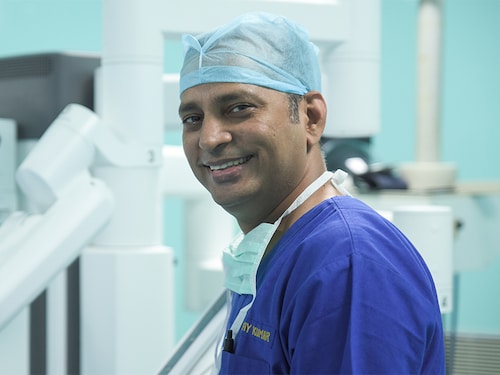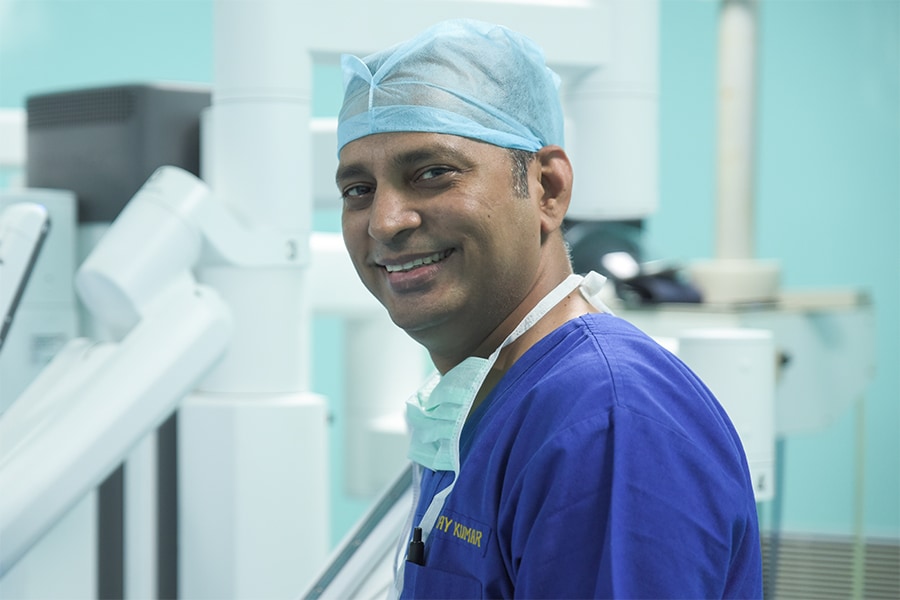Prostate Cancer and Robotic Surgery
Dr Abhay Kumar, MBBS; MS;DNB (urology), Consultant urologist,Uro-oncologist & Robotic Surgeon, Narayana Superspeciality Hospital Howrah, Kolkata



Prostate cancer is a disease in which malignant (cancer) cells form in the tissues of the prostate. The prostate is a gland in the male reproductive system located just below the bladder and in front of the rectum. It is about the size of a walnut and surrounds the urethra (the tube which empties urine from the bladder). The prostate gland produces fluid which makes up part of the semen.
Prostate cancer is the second most common form of cancer affecting men. More than seventy percent of men diagnosed with prostate cancer each year are over the age of 65. There are no noticeable symptoms of prostate cancer while it is still in the early stages, making the PSA test a critical screening tool. The optimal time for prostate cancer treatment is before symptoms appear. In more advanced stages, symptoms may include difficult or frequent urination, blood in the urine or bone pain.
If the cancer has not spread outside the prostate gland, surgical removal of the prostate and surrounding tissues is the standard choice of treatment. The main type of surgery for prostate cancer is a radical prostatectomy. Conventionally, radical prostatectomy was carried out using open surgery. However, with the advent of recent technologies radical prostatectomy is carried out using minimal invasive techniques such as laparoscopy and robotic prostate surgery.
Robotic surgery, or robot-assisted surgery, is advancement in surgical techniques where a surgeon uses a computerized robotic arm with small tools attached to it to carry out complex surgeries. Robotic surgical system provides the surgeon a high-definition, magnified (12à—), 3-D view of the surgical site. The surgical instruments are controlled by the surgeon using the console, to direct special surgical instruments which are smaller in size, and more flexible than the human hand.
The robot does not perform the surgery on its own. The movement of the surgeon’s hand just mimicked by the instruments attached to the robotic arms, while this is completely controlled by the surgeon. Robot assisted surgeries offer precise action that is devoid of hand tremors, enabling the surgeon to perform the most complex procedures with enhanced precision, dexterity and control.
Compared with traditional open surgery, patients who undergo robotic-assisted radical prostatectomy experience:
• Less blood loss
• Less pain
• Shorter hospital stays
• Faster recovery times (although catheter needs to remain in bladder for same amount of time after robotic or open procedure).
Robotic prostate cancer surgery system is able to provide superior clinical prostate cancer treatment results when compared to non-robotic traditional and scope-assisted procedures. More traditional scope-assisted surgery typically provides a much lower resolution image, and a far more limited field of vision. Where as in robotic assisted surgery system’s sensitive electronics and one-centimeter diameter surgical arms allow the surgeon to make highly precise movements inside the incision during robotic prostate cancer surgery.
Due to the proven benefits of robotic assisted surgery, it has become the treatment of choice for robotic surgeons across leading global hospitals. However, do remember that the effectiveness of any surgery, especially robotic surgery, depends on the surgeon doing it. And hence, the more experienced and skilled a surgeon, the more successful any surgery will be.
The pages slugged ‘Brand Connect’ are equivalent to advertisements and are not written and produced by Forbes India journalists.
First Published: Jul 13, 2021, 14:44
Subscribe Now